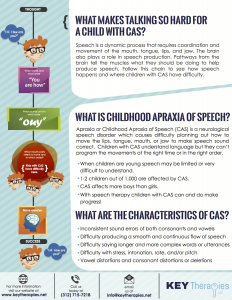Apraxia
Information taken from American Speech-Language Hearing Association (ASHA) and the Childhood Apraxia of Speech Association of North America (CASNA)
WHAT IS APRAXIA?
Apraxia or Childhood Apraxia of Speech (CAS) is a motor planning disorder which impacts a child’s ability to accurately move the structures (i.e., tongue, lips, palate, and jaw) that are necessary for speech. Children who have CAS have difficulty producing sounds, syllables, and words. For reasons unknown, the brain has trouble telling the body part how to correctly produce sounds. Children with CAS know exactly what they want to say but they have a difficult time producing clear speech that is easily understood. Their speech is often difficult to understand because their brain is not sending the right message to the tongue, lip, palate, and / or jaw to correctly produce the sound. They have difficulty planning or programming speech movements.
WHAT ARE THE CHARACTERISTICS OF CAS?
Not all children who have apraxia have the same symptoms and these symptoms may differ from child to child. Furthermore, some of the symptoms of apraxia are also seen in children who have other speech delays or disorders. Therefore, it can sometimes be difficult to determine if your child has CAS without the help of a professional. It is important to have your child evaluated by a speech-language pathologist if you have concerns with your child’s speech development. A speech pathologist has knowledge of CAS and would be able to help with your speech concerns. Below are some general signs and symptoms of apraxia.
Key Characteristics of CAS:
- Inconsistent sound errors
- For example different sound errors on the same word. If a child was supposed to say “pen” 3 times, he may say “fen”, “shen”, and “men”.
- Difficulty saying longer and more complex words or utterances

- Difficulty sequencing speech sounds
- Sounds may have breaks between the syllables
- Speech may sound “choppy”
- Increased difficulty with volitional (willful or purposeful) speech
Characteristics that a child with CAS may demonstrate that are common in children with other speech-language delays or disorders:
- Very difficult to understand child’s speech
- Child can understand more than he / she says
- Delayed babbling
- Delayed first words
- Using only a few different speech sounds
- Loss of previously spoken words
WHAT CAUSES CAS?
The cause for apraxia is unknown; however, some possible causes may include genetic disorders, stroke, or brain injury.
OUR APPROACH AT KEY THERAPIES:
Treatment for CAS includes frequent and intensive speech therapy sessions. Studies have found that children with CAS benefit from individualized speech therapy sessions multiple times throughout the week. Sessions will provide the child with an opportunity to practice the sequencing movements necessary to produce speech that can be understood. The sounds that the child displays difficulties with will be targeted in words, phrases, sentences, and in conversation in order to create speech that is more easily understood by listeners. As your child progresses, speech therapy may not be needed as often.
